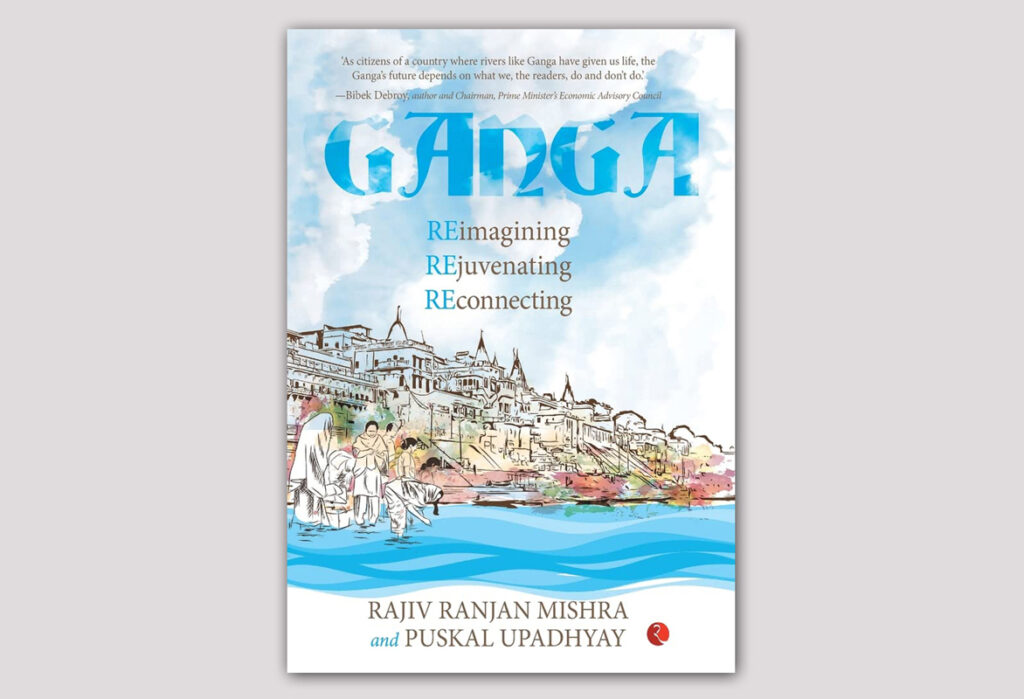Insider’s account of Ganga Rejuvenation shared by Rajiv Ranjan Mishra and Puskal Upadhyay during a discussion on their new book
New Delhi: The much-awaited discussion on the book Ganga: Reimagining, Rejuvenating, Reconnecting was organised virtually by Rishihood University, City Book Leaders and Rupa Publications. The book is co-authored by Rajiv Ranjan Mishra, Former Director-General, National Mission for Clean Ganga, Retired IAS and Puskal Upadhyay, IDAS Financial Advisor, NDMC.
Apart from being India’s longest and most revered river, Ganga and her tributaries traverse eleven states and provide a livelihood to nearly 43 percent of Indians. Despite being so special, Ganga has been getting polluted, with its ecology and flow endangered. Many initiatives to clean the river ended up either being hugely inadequate or dismal failures. The dilemma before the new team of National Mission for Clean Ganga was not just the enormity of the task, but also have to bear the scar of past failures. This haunting legacy stayed with them every step of the way in their long, complex and daunting journey.
From the beginning, the team adopted a radically different and holistic approach to resolve the ‘wicked problem’ while dealing with multiple stakeholders and their clash of ideas on the road ahead. This insider’s account by two change-makers chronicles this long and complex journey so far transcending the challenges of over-abstraction of water, pollution abatement, bringing behavioural change, and making collaborative partnerships to achieve their goals. More importantly, it brought back some of the love and respect of the people for its Mother and Goddess.
Shri Rajiv Ranjan Mishra, shared that the efforts for cleaning Ganga had been made for many years but the novelty of Namami Gange Mission was mainly in terms of its comprehensiveness and sustainability of efforts. “There was a shift from cleaning Ganga to Rejuvenating Ganga, a paradigm shift”, he added. He also spoke about the advantages he had in terms of adequate resources and freedom of taking prompt decisions.
Shri Puskal Upadhyay its co-author, shared his experience of working on the project and the book reflecting his bond with Ganga. In his words, “once you connect with Maa Ganga, she transforms you.” Speaking about the uniqueness of Ganga waters he shared that it was not just a matter of faith but a study conducted in association with National Environmental Engineering Research Institute (NEERI) had also confirmed unique properties of its waters enabling Ganga to retain a near saturation dissolved oxygen state in spite of heavy pollution load. This is primarily attributable to existence of bacteriophages, effect of its flora and fauna in upper reaches and the minerals in its bed.
Speaking about the role of villages in reviving Ganga, Rajiv Ranjan Mishra emphasized that making people aware about their livelihood being linked to river in rural areas was a very significant step. From building toilets to encouraging organic farming it is a very holistic approach. Even rural youth (trained as Ganga Praharis, NYK Ganga Doots and Ganga Mitras) came forward to preserve Ganga’s biodiversity by saving dolphins, turtles, cleaning river banks and protecting wetlands etc. Puskal Upadhyay added that in urban areas the threat to the river comes from the absence of people river connect but villages especially Ganga Grams could come up as ideal communities in sync with river and set example for urban areas. Taking up the challenge in villages would prevent worsening of situation unlike in urban areas.
Shri Mohit Gupta, coordinated the talk on behalf of City Book Leaders. He said that the book is a story of change. It shows how we can include every part of society to bring a change. He shared that his biggest take away from the book is that there is no bigger and better teacher than nature itself. Shri Sahil Aggrawal, CEO, Rishihood University congratulated the authors and said that the book is an eye-opener on the challenges of rejuvenating a massive river like Ganga. He added that the book also makes an interesting management case-study. He updated the audience on upcoming programmes on water issues in the university.
The authors are categorical that the task is not yet over, much more needs to be done. However, the successful journey so far, as demonstrated by the findings of this book, is a testament to the fact that a job well begun is not just half done, but also provides a road map for future successes.
The book is published by Rupa Publications. It is available on all leading online platforms and book stores.

More Stories
Indian Culture rewind by Anish Rangrej – Impacting Globally
Velore Perfumes: Long Lasting Super Affordable Perfumes Crafted for Indian Weather
Lotus Derma Botanics unveils its debut campaign for it’s Blemish Free Face Wash